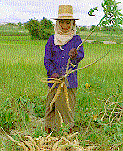
Solar energy units power irrigation pumps

Buffalo plowing the rice fields

Bunches of rice to be transplanted in new fields

A farmer harvesting tapioca
 Solar energy units power irrigation pumps
|
 Bunches of rice to be transplanted in new fields
|
Khao Hin Son, a Royally Initiated Project, Bonnie Divis, Holiday Time in Thailand, sep. - oct. 1986, P. 9-11.